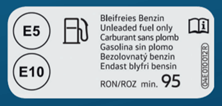
Lantmännen is an agricultural cooperative and Northern Europe’s leader in agriculture, machinery, bioenergy and food products.
Switching from E5 to E10 fuel reduces emissions immediately. But what is E10, which cars can run on E10 gasoline and why is it smart to use ethanol as a fuel? Find the answers here.
E10 is gasoline with up to 10%vol blend of renewable ethanol. E10 complies with current fuel legislation and the European gasoline standard, SS-EN 228.
The introduction of E10 in Sweden is done to gradually reduce the proportion of fossil raw materials in our fuels. E10 is simply a better choice for the climate. The government has introduced a reduction obligation for gasoline, which means that the proportion of renewable ethanol in gasoline must increase to reduce greenhouse gas emissions from our transport. In Sweden, we have previously been able to fill our vehicles with gasoline with 5% ethanol, but now the standardization requirement for gasoline has increased to 10% ethanol content. Increasing the blend of ethanol in the gasoline from 5% to 10% reduces the fossil carbon dioxide emissions per consumed liter.
The majority of all gasoline engines and passenger car models can run on E10 gasoline, but there are older vehicles with restrictions. If your car can only run on a maximum of 5% ethanol, you can run on E5 gasoline. Click on the link below to see if your car can run on E10 gasoline. The list is compiled by the industry organization Bilsweden in 2011 - but is still valid as all cars manufactured after 2011 can run on E10. If your car is not on the list, please contact your vehicle manufacturer.
Which petrol cars can fill up with E10?
You can fill up with E10 at regular gas stations. Look for the E10 symbol on the pump or pump gun.
A symbol on the pump and pump gun indicates whether it is E5 or E10 gasoline. The symbol consists of a circle with E5 or E10 in the center. The symbol is located on the pump handle and above the pump at the fuel station. In newer cars, produced from October 2018 onwards, there is a round E10 symbol on the fuel cap (see below). Often the E5 symbol is also found on the fuel cap. If your car has an E10 symbol, you can always fill up with E5 as well.
Since 2009, E10 has been gradually rolled out across Europe and is now available in 17 European countries: Belgium, Bulgaria, Denmark, Estonia, Finland, France, Latvia, Lithuania, Luxembourg, the Netherlands, Romania, Slovakia, Sweden and the United Kingdom. In the United States, E10 is also widespread and since January 2011 it is allowed to mix up to 15% ethanol with gasoline (E15) for cars and light trucks of model year 2001 or later.
E10 contains 90% gasoline and up to 10% ethanol.
Ethanol (C2H5OH) is an alcohol that can be used as a fuel. Today, ethanol is by far the most widely used biofuel in the world and plays an important role in reducing the climate impact of transport and dependence on oil. Complete combustion produces only carbon dioxide and water.
Ethanol is mainly produced from starchy crops such as cereals, but also from residues and waste from various industries. The raw material used to produce ethanol is fully renewable and complies with Swedish and European sustainability regulations.
Ethanol contributes to significantly lower CO2 emissions compared to fossil fuels such as gasoline. Thanks to ethanol produced in Europe (by members of the industry association ePURE), emissions in 2019 were reduced by more than 72% compared to fossil gasoline. The more ethanol mixed in, the better the results for the climate. Today, there are several 100,000 cubic meters of European ethanol contributing to close to 100% reduction of emissions (as calculated according to EU/SE standard calculation methods dictated by the European Renewable Energy Directive that came into force in 2010 and is renewed in 2021 (Renewable Energy Directive, ("RED") 2009/28/EC of 23 April 2009 and amendments (e.g. 2018/2001/EU, REDII)).
The ethanol produced in Europe contributes on average to about 78% lower CO2 emissions compared to fossil fuels such as gasoline. The ethanol we produce at Lantmännen Biorefineries is among the world's most sustainable with up to 100% CO2 reduction.
The more ethanol blended into gasoline, the better it is for the climate. The widespread introduction of E10 in Europe is an important step for the EU to ensure its climate goals in the transport sector.
The EU has set climate targets and decided how to calculate the climate impact when comparing different biofuels with fossil alternatives, such as comparing ethanol with fossil gasoline. The calculation takes into account CO2 emissions along the entire value chain of the biofuel's production and compares how much lower CO2 emissions it is compared to the fossil fuel it replaces in, for example, fossil gasoline.
Everything must be calculated according to the same guidelines, which means that the CO2 savings between different alternatives can be compared and can be optimized for rapid and efficient climate change in our transport sector. Lantmännen Biorefineries' ethanol reduces CO2 emissions by up to 98% compared to fossil gasoline.
Ethanol is most commonly used as a renewable component in gasoline and in a range of technical applications.
The Nordic region's largest biorefinery, Lantmännen Biorefineries, is located in Norrköping in Östergötland - an area with a long tradition of being a grain-rich region.

